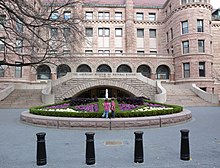
The American Museum of Natural History (abbreviated as AMNH), located on the Upper West Side of Manhattan,New York City, is one of the largest museums in the world. Located in park-like grounds across the street fromCentral Park, the museum complex comprises 27 interconnected buildings housing 45 permanent exhibition halls, in addition to a planetarium and a library. The museum collections contain over 32 million specimens of plants, humans, animals, fossils, minerals, rocks, meteorites, and human cultural artifacts, of which only a small fraction can be displayed at any given time, and occupies 2,000,000 square feet (190,000 m2). The museum has a full-time scientific staff of 225, sponsors over 120 special field expeditions each year,[5] and averages about five million visits annually.[6]
The mission statement of the American Museum of Natural History is: "To discover, interpret, and disseminate—through scientific research and education—knowledge about human cultures, the natural world, and the universe."
Before construction of the present complex, the museum was housed in the Arsenal building in Central Park. Theodore Roosevelt, Sr., the father of the 26th U.S. President, was one of the founders along with John David Wolfe, William T. Blodgett, Robert L. Stuart, Andrew H. Green, Robert Colgate, Morris K. Jesup, Benjamin H. Field, D. Jackson Steward, Richard M. Blatchford, J. P. Morgan, Adrian Iselin, Moses H. Grinnell, Benjamin B. Sherman, A. G. Phelps Dodge, William A. Haines, Charles A. Dana, Joseph H. Choate, Henry G. Stebbins, Henry Parish, and Howard Potter. The founding of the museum realized the dream of naturalist Dr. Albert S. Bickmore. Bickmore, a one-time student of Harvard zoologist Louis Agassiz, lobbied tirelessly for years for the establishment of a natural history museum in New York. His proposal, backed by his powerful sponsors, won the support of the Governor of New York, John Thompson Hoffman, who signed a bill officially creating the American Museum of Natural History on April 6, 1869.[7]
In 1874, the cornerstone was laid for the museum's first building, which is now hidden from view by the many buildings in the complex that today occupy most of Manhattan Square. The original Victorian Gothic building, which was opened in 1877, was designed by J. Wrey Mould, both already closely identified with the architecture of Central Park It was soon eclipsed by the south range of the museum, designed by J. Cleaveland Cady, an exercise in rusticated brownstone neo-Romanesque, influenced by H. H. Richardson.[9] It extends 700 feet (210 m) along West 77th Street, with corner towers 150 feet (46 m) tall. Its pink brownstone and granite, similar to that found atGrindstone Island in the St. Lawrence River, came from quarries at Picton Island, New York.[11] The entrance on Central Park West, the New York State Memorial to Theodore Roosevelt, completed by John Russell Pope in 1936, is an overscaled Beaux-Arts monument.It leads to a vast Roman basilica, where visitors are greeted with a cast of a skeleton of a rearing Barosaurus defending her young from an Allosaurus. The museum is also accessible through its 77th street foyer, renamed the "Grand Gallery" and featuring a fully suspended Haida canoe. The hall leads into the oldest extant exhibit in the museum, the hall of Northwest Coast Indians














No comments:
Post a Comment